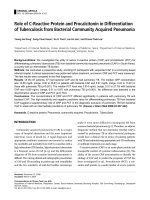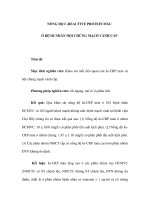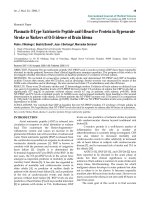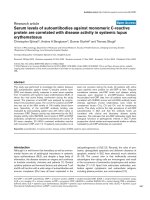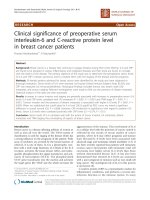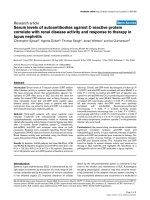Role of highly sensitive C- reactive, protein, Interleukin-6 and procalcitonin in early diagnosis of neonatal sepsis
Bạn đang xem bản rút gọn của tài liệu. Xem và tải ngay bản đầy đủ của tài liệu tại đây (178.32 KB, 8 trang )
Int.J.Curr.Microbiol.App.Sci (2019) 8(4): 245-252
International Journal of Current Microbiology and Applied Sciences
ISSN: 2319-7706 Volume 8 Number 04 (2019)
Journal homepage:
Original Research Article
/>
Role of Highly Sensitive C- Reactive, Protein, Interleukin-6 and
Procalcitonin in Early Diagnosis of Neonatal Sepsis
Parul Singhal*, Vichal Rastogi and Ayesha Nazar
Department of Microbiology, School of Medical Sciences and Research, Sharda University,
Greater Noida-201306, Uttar Pradesh, India
*Corresponding author
ABSTRACT
Keywords
Blood culture,
Neonatal sepsis,
EONS (Early onset
neonatal sepsis),
LONS (Late onset
neonatal sepsis),
Hs-CRP (Highly
Sensitive C-reactive
protein), (PCT)
Procalcitonin, IL-6
(Interleukin-6)
Article Info
Accepted:
04 March 2019
Available Online:
10 April 2019
The diagnosis of neonatal sepsis is difficult because clinical manifestation is non-specific.
Timely detection and treatment will help in decreasing mortality and morbidity. Blood
culture is gold standard but the diagnosis is often retrospective. Thus there is a need for an
alternative method which is more rapid, reliable and sensitive. This study was designed to
determine the sensitivity, specificity, NPV, PPV and accuracy of hs-CRP, IL-6 and PCT
levels, as a diagnostic marker of EONS. 206 neonates with sign and symptoms of sepsis
admitted in NICU were included in this study. Blood culture was performed by Bac
T/Alert 3D method, hs-CRP, IL-6 and PCT by ELISA. Low birth weight and prematurity
were the most common risk factors present in 74% of EOS and 66% of LOS cases.
Prolonged IV antibiotics were a risk factor in 26.4% in EOS and 50% in LOS. CoNS
(44.1%) was the predominant bacterial pathogen isolated, followed by Staphylococcus
aureus (11.7%), Escherichia coli (11.7%), Acinetobacter baumanii (8.8%) and Klebsiella
pneumoniae (8.8%) in EOS cases. Cut off value of 5 mg/ml for hs-CRP, <20 pg/ml for IL6 and <12 pg/ml for PCT were taken as negative. PCT is more sensitive and specific in
EOS than IL-6 followed by hs-CRP. Both PCT and IL-6 are equally good markers, if
patient presented later.
gestational age play a major role in the
incidence of septicemia, which increases with
decreasing gestational age [Stoll B.J., Hansen
et al., 2010 Murphy et al., 2012). In addition
the case fatality rate for early and late onset
sepsis has been reported as high as 40% and
19.7% respectively (Motara et al., 2005).
According to report of the WHO, about 5
million deaths are caused annually by
neonatal septicemia (Kayange et al., 2010)
Introduction
According to National Neonatal Perinatal
Database from hospitals, the incidence ranges
from 0.1% to 4.5% with an overall mortality
rate varying from 22-30%. In the Western
literature, the incidence of neonatal sepsis
ranges from 0.01 to 0.8 percent, although
early onset and late onset septicemia have
different incidences but other factors such as
245
Int.J.Curr.Microbiol.App.Sci (2019) 8(4): 245-252
National Neonatology Forum of India defines
neonatal sepsis as follows (National
Neonatology Forum of India, 2002):
Western countries is rarely encountered in
Indian scenario (Chugh, 1988 and Chaturvedi,
1989).
Proven sepsis
The manifestation of sepsis depends on
whether it is `early onset’ or `late onset’ and
association of serious bacterial infection e.g.,
meningitis, septicemia, pneumonia, bone and
joint infection, urinary tract infection and
necrotizing enterocolitis.
The baby presents with clinical picture of
sepsis and isolation of pathogens from blood,
C.S.F., Urine or other body fluids or autopsy
evidence of sepsis. Probable Sepsis: Newborn
with clinical picture suggestive of sepsis with
one or more of the following criteria: 1.
Existence of predisposing factors e.g.,
maternal fever, foul smelling liquor or
prolonged rupture of the membrane (> 12
hours) or gastric polymorphs more than
6/high power field. 2. Positive septic screen
(Two of the four parameters to be present)
Total leucocytes count < 5,000/mm3,
immature to total neutrophil count ratio > 0.2,
C-reactive protein positive and micro ESR >
15 mm/ Ist hour or > age in days + 3. 3.
Radiological evidence of pneumonia.
Isolation of microorganism from body fluids
such as blood, CSF and urine remains the
gold standard method for diagnosis of
neonatal infection, but microbiological culture
is not available before at least 36-48 hrs
(Fanaroff and MacDonald, 2006). In order to
prevent microbial resistance induced by
unnecessary administration of antibiotics, a
definite diagnosis should be made using
laboratory test with higher diagnostic value
(Alireza and Shahian, 2007).
The commonly used markers are TNF-alfa
(Tumor
necrosis
factor-alfa),
IL-6
(Interleukin-6), IL-8 (interleukin-8), CRP (creactive protein), hs CRP (highly sensitive Creactive protein) and PCT (procalcitonin).
Procalcitonin concentrations increase within 2
to 4 hours, after an exposure, peaks at 6 to 8
hours and remains elevated for the next 24
hours. Procalcitonin is secreted mainly by the
neuroendocrine cells of the lungs and
intestine in response to bacterial endotoxin or
inflammatory cytokines (TNF, IL-6) (Maruna
et al., 2000).
Escherichia coli, Group B Streptococcus
(GBS), Coagulase-negative Staphylococcus
(CoNS), Haemophilus influenza and Listeria
monocytogenes happen to be most common
organisms (Stoll BJ, 2005, Abdollah A 2012,
van den Hoogen A 2009) and In contrast, late
onset sepsis (>72 hours-28 days) LOS is most
commonly caused by CoNS, Staphylococcus
aureus, E. coli, Klebsiella and Pseudomonas
spp (Stoll, 2005; Abdollah, 2012; van den
Hoogen, 2009; Sharma, 1987).
The common organisms reported by NNPD
(National Neonatal Perinatal Database)
Survey showed 3.8% incidence of neonatal
sepsis from pooled hospital data with
Klebsiella,
Staph
aureus,
E.
coli,
Pseudomonas,
Enterobacter,
Coagulase
negative Staphylococcus, Acinetobacter and
candida as the predominant organisms. Group
B Streptococcus, which is a common
etiological agent of early onset sepsis in
It does not rise significantly with viral or
noninfectious inflammations, hence it is
highly specific
to
bacterial
sepsis.
Furthermore, PCT is released into the
circulation within 3 hours of onset of
infection, plateaus at 6 hours, and remains
elevated for 24 hours. This makes PCT a
promising new agent for early and sensitive
identification of infected neonates (José B
246
Int.J.Curr.Microbiol.App.Sci (2019) 8(4): 245-252
López Sastre et al., 2007). Interleukin 6 (IL6), a chemokine produced by the T and B
lymphocytes. Its level increases 2 days before
clinical diagnosis of sepsis. It is more
sensitive than CRP, but it cannot be used as a
sole marker of sepsis, as it has a short half
life. CRP is a rapidly responsive acute phase
reactant, which is synthesized by the liver
within 6-8 hours of stimulus of inflammatory
process. Highly sensitive CRP (hs-CRP) is
more sensitive than the conventional CRP, hsCRP assays measures the CRP levels lower
than that measured by the conventional CRP
assays because newborns cannot produce
sufficient amount of acute phase proteins and
so they respond to infection with a smaller
increase in CRP. It’s measurement below
1mg/l provides increased sensitivity for
neonatal infection (Edgar DM, Gabriel,
2002]. This test is often requested to help
discriminate viral infections from bacterial
infections or monitor the response to
antibiotics.
This study was conducted in the Department
of Microbiology at Sharda Hospital, Greater
Noida. This study was approved by the
Institutional
Scientific
and
Ethical
Committee, and written informed consents
were obtained from the parents.
A total of 206 neonates with suspected sepsis
who required sepsis evaluation were
considered. The inclusion criteria were
neonates who were admitted to the NICU
with clinical signs suggestive of sepsis. The
exclusion criteria were infants who were on
antibiotics or those who had congenital
anomalies. According to WHO IMNCI
guidelines possible serious bacterial infection
include following criteria: convulsions or fast
breathing (60 breaths per minute or more) or
nasal flaring or grunting or bulging fontanelle
or 10 or more skin pustules or a big boil or
axillary temperature 37.5°C (or feels hot to
touch) or temperature less than 35.5°C (or
feels cold to touch) or lethargy or
unconsciousness or less than normal
movement.
Finding a reliable laboratory test as a marker
for immediate detection of infection with
acceptable sensitivity and specificity has
always
been
controversial
among
investigators, no single test is of high
diagnostic value. Therefore, a combination of
at least 2 or more tests, if abnormal, leads to
an increase in predictability for early
diagnosis of neonatal sepsis. In previous
studies IL-6, PCT and hs-CRP were not
evaluated simultaneously. This is an attempt
done in a Microbiology Department of Sharda
University to evaluate the serum levels of IL6, PCT and hs-CRP as early diagnostic
markers in neonatal infection.
Blood culture
Blood culture was performed by automated
blood culture system in all the cases.
Approximately 1 ml of blood was inoculated
aseptically into BacT/Alert pediatric blood
culture bottle. BacT/Alert bottles were
incubated in BacT/Alert 3D system for 7
days. Growth obtained was identified by
standard
microbiological
techniques.
Identification of the organisms was based on
cultural characteristics, results of various tests
and biochemicals.
PCT, IL-6, CRP assay
Materials and Methods
Blood samples were centrifuged within 30
minutes of collection. Serum was stored at 20 degree Celsius before analysis.
Manufacturer’s instructions were followed
during testing and interpretation of the three
The prospective study was conducted on
neonates admitted for sepsis workup in the
Neonatal ICU of Sharda Hospital, Greater
Noida from January 2017 to December 2017.
247
Int.J.Curr.Microbiol.App.Sci (2019) 8(4): 245-252
serological acute phase markers. PCT levels
were estimated by a quantitative ELISA kit
(Boster Human Procalcitonin (PCT) ELISA
Kit). IL-6 levels by a quantitative ELISA kit
(Boster IL6 ELISA kit) in serum and a solid –
phased enzyme immunoassay for the
quantitative determination of hs-CRP in
serum.
were blood culture positive and remaining
112 (54.3%) were blood culture negative.
Pure bacterial growth was obtained from
46/206 (22.3%) cases.
Out of the total 46 bacterial culture positive
cases of sepsis, 34/46 (73.91%) cases were in
the age group (<72 hours) known as Early
onset sepsis (EOS) and 12 (26.08%) cases
were in the group (>72 hours-28 days) known
as Late onset sepsis (LOS).
According to time of onset of clinical
symptoms of sepsis, neonates were classified
into two categories of infection as follows: (a)
Group І Early onset sepsis (EOS):< 72 hours
(b) Group ІІ Late onset sepsis (LOS): (>72
hours-28 days)
Lethargy and feed intolerance were the most
common clinical presentation in both EOS
and LOS, present in almost 100% of cases
followed by respiratory distress in 78% and
50% cases of EOS and LOS respectively
Data collection and management
Self-designed, pre tested proforma was used
to collect demographic data, clinical
presentation, associated risk factors (maternal
& neonatal), results of the laboratory
investigation generated during the admission.
Risk factors
Statistical analysis
Low birth weight and prematurity were the
most common risk factors present in 74% of
EOS and 66% of LOS cases. Prolonged IV
antibiotics were a risk factor in 26.4% in EOS
and 50% in LOS and ventilator support were
less common risk factors observed.
Distribution of various risk factors associated
with EOS and LOS in neonates is shown in
Table 1 and 2.
All the statistical data analysis was done with
the help of the SPSS version 22. For
qualitative and quantitative data, Chi square
test was done to analyze the data. p value less
than or equal to 0.05 was considered to be
statistically significant.
Isolation of different bacterial species
Coagulase negative Staphylococcci (44.1%)
was the predominant bacterial pathogen
isolated, followed by Staphylococcus aureus
(11.7%),
Escherichia
coli
(11.7%),
Acinetobacter
baumanii
(8.8%)
and
Klebseilla Pneumoniae (8.8%) in EOS cases
(Table 3).
Results and Discussion
A total of 206 neonates with sign and
symptoms of sepsis admitted in NICU of
Sharda Hospital were included in this study
with the aim to study the role of hs- CRP, IL6 and PCT in the diagnosis of neonatal sepsis
in a tertiary care hospital and to correlate the
findings of quantitative hs-CRP, IL-6 and
PCT with Blood culture in cases of neonatal
bacterial sepsis.
However, Coagulase negative Staphylococcci
(41.6%) was the predominant bacterial isolate
in LOS cases, followed by Staphylococcus
aureus (16.6%) and Acinetobacter lowffi
(8.8%) (Table 4).
Out of 206 clinically suspected cases of
neonatal sepsis screened, 94 (45.6%) cases
248
Int.J.Curr.Microbiol.App.Sci (2019) 8(4): 245-252
A total of 206 cases of suspected neonatal
septicemia were selected on the basis of
clinical presentations and risk factors
associated with it. Blood culture was positive
in 45.6% cases. Pure bacterial growth was
obtained in 22.3% of cases.
Coagulase Negative Staphylococci were the
predominant bacterial pathogen isolated in
both EOS and LOS (44% and 41%
respectively).
Staphylococcus
aureus
(11.7%),
Escherichia
coli
(11.8%),
Acinetobacter
baumannii
(8.8%)
and
Klebsiella pneumonia (8.8%) were other
pathogen isolated in EOS and Acinetobacter
lwoffi (16.6%), Staphylococcus aureus (6.4%)
and Enterococcus species (8.3%) were
isolated from cases of LOS.
A total of 74% cases were of EOS and 26%
were of LOS. Lethargy and feed intolerance
were the most common clinical presentation
in both EOS and LOS, present in almost
100% of cases by respiratory distress in 78%
and 57% of cases of EOS and LOS cases
respectively. Bleeding tendency, convulsions
and poor perfusion were the other less
common clinical presentations. Low birth
weight and prematurity were the most
common risk factors present in 74% of EOS
and 66% of LOS cases.
In EOS Sensitivity, Specificity, PPV, NPV
and Accuracy for PCT was 82.35%, 77.5%,
75.6%, 83.18% and 79.72%. For IL-6 was
76.47%, 70%, 68.4%, 77.7% and 72.97%
respectively and for hs-CRP it was Sensitivity
70.5%, Specificity 60%, PPV 60%, NPV
70.5% and Accuracy 64.86%.
Table.1 Distribution of various risk factors identified in cases of EOS (n= 34)
Risk Factors
No. of cases
Percentage %
Low birth weight
25
74.51%
Prematurity
25
74.51%
Prolonged IV antibiotics
9
26.4%
Ventilator Support
3
10%
Table.2 Distribution of various risk factors identified in cases of LOS (n=12)
Risk Factors
No. of cases
Percentage %
Low birth weight
8
66.6
Prematurity
8
66.6
6
50
4
33.3
Prolonged
antibiotics
Ventilator support
IV
249
Int.J.Curr.Microbiol.App.Sci (2019) 8(4): 245-252
Table.3 Various bacterial pathogen isolated from blood culture in cases of EOS (n=34)
`
Number
%
Coagulase Negative Staphylococci
15
44.1
Staphylococcus aureus
4
11.7
Escherichia coli
4
11.7
Acinetobacter baumannii
3
8.8
Streptococcus viridians
1
2.9
Enterococcus faecium
1
2.9
Klebsiella pneumonia
3
8.8
Citrobacter koseri
1
2.9
Pseudomonas species
2
5.8
Table.4 Various bacterial pathogen isolated from blood culture in cases of LOS (n=12)
Bacteria (n=12)
Number
Coagulase Negative Staphylococci
5
41.6
Staphylococcus aureus
2
16.6
Acinetobacter lowffi
2
16.6
Enterococcus spp
1
8.3
Citrobacter freundii
1
8.3
Pseudomonas species
1
8.3
250
%
Int.J.Curr.Microbiol.App.Sci (2019) 8(4): 245-252
In LOS the Sensitivity, Specificity, PPV,
NPV and Accuracy for PCT was 66.6%, 50%,
66.6%, 50% and 60%. For IL-6 was 66.6%,
50%, 66.6%, 50% and 60%. For hs-CRP
50%, 75%, 75%, 50% and 60% respectively.
Peadiatrics. 126(3): 443-56.
Alireza A, et al., 2012. Diagnostic value of
simultaneous
measurement
of
procalcitonin, IL-6 and hs-CRP in
prediction of neonatal sepsis Me diter
J Hematel Infect Dis.1:4(1).
Chaturvedi P, et al., 1989. Analysis of blood
culture isolates from neonates of a
rural hospital. Indian Pediatrics.26(5):
460-5.
Chugh K, et al., 1988. Bacteriological profile
of neonatal septicemia. The Indian
Journal of Pediatrics.55(6):961-5.
Edgar DM, et al., 2010. prospective study of
the sensitivity, specificity and
diagnostic performance of soluble
intercellular adhesion molecule 1,
highly sensitive C-reactive protein,
soluble E-selectin and serum amyloid
A in the diagnosis of neonatal
infection. J. BMC Pediatrics. 10(1):
22:1-16.
Fanaroff A, Martin R. 2006. Neonatal
perinatal medicine. 8th ed. Mosby;
791-799.
Kayange N., et al., 2010. Predictors of
positive blood culture and deaths
among neonates with suspected
neonatal sepsis in a tertiary hospital,
MwanzaTanzania.BMCPediatr.10(1):
39-3.
MacDonald M, et al., 2005. Avery’s
Neonatalogy,
Neonatal
pathophysiology and management of
the newborn. 6th ed. Philadelphia:
Lippincott Williams&Wilkins.p.12361251.
Motara F., et al., 2005. Epidemiology of
neonatal sepsis at Johnnesburg
hospital. South Afr. J. Epidemiol.
Infect. 20(3): 90-3.
Murphy K., Weiner J. 2012. Use of leucocyte
counts in evaluation of early onset
neonatal sepsis. Pediatr. 31(1):16-9.
National Neonatology Forum of India 2002.
Department
of
Pediatrics
&
PCT is more sensitive and specific in EOS
than IL-6 followed by hs-CRP. PCT was
higher as compared to IL-6 and hs-CRP in
patients with clinical evidence of EOS and
even higher in those with a positive blood
culture with a mean level 5.52 ng/ml.
Probably this was because the neonates
presented to our hospital earlier within 72
hours of age. Both PCT and IL-6 are equally
good markers, if patient presented later.
Whereas, hs-CRP has comparatively higher
specificity as compare to PCT and IL-6 in
LOS.
Clinical improvement was observed more in
cases of LOS (91.66%) than EOS (89.13%).
Similarly the mortality rate was less in LOS
(2.17%) as compared to EOS (10.86%).
Probably a combination of all the three
markers should be used to screen neonatal
sepsis cases as all biomarkers rises at different
hours of sepsis and has different half life.
Ethical approval
The study was conducted after obtaining
ethical approval from the institutional ethical
committee.
References
Abdollah A, et al., 2012. “Diagnostic value of
simultaneous
measurement
of
Procalcitonin, Interleukin 6 and Hs
CRP in prediction of Early Onset
Neonatal Sepsis.” Mediterr J Hematol
Infect Dis. V4(1) Stoll B.J., et al.2010
Neonatal outcomes of extremely
preterm infants from the NICHD
Neonatal
Research
Network.
251
Int.J.Curr.Microbiol.App.Sci (2019) 8(4): 245-252
Neonatology, AIIMS, New Delhi.
Ng PC, et al., 1997. Diagnosis of late onset
neonatal sepsis with cytokines,
adhesion molecule, and C-reactive
protein in preterm very low birth
weight infants. Arch Dis Child Fetal
Neonatal Ed 77:F221-227.
Shahian M, Pishva N, Kalani M. 2010.
Bacterial etiology and Antibiotic
sensitivity patterns of Early-Late onset
Neonatal sepsis among Neoborns in
Shiraz, Iran 2004-2007. 16; 35(4):
293-8.
Sharma PP, et al., 1987. Bacteriological
profile of neonatal septicemia. Indian
Pediatrics. 24: 1011-7.
Stoll B.J., et al., 2010. Neonatal outcomes of
extremely preterm infants from the
NICHD Neonatal Research Network.
Peadiatrics. 126(3): 443-56.
Van den Hoogen A, et al., 2009. Long term
trends in the epidemiology of neonatal
sepsis and Antibiotic susceptibility of
Causative
Agents.
Neonatalogy.
97(1):22-28.
How to cite this article:
Parul Singhal, Vichal Rastogi and Ayesha Nazar. 2019. Role of Highly Sensitive C- Reactive,
Protein, Interleukin-6 and Procalcitonin in Early Diagnosis of Neonatal Sepsis.
Int.J.Curr.Microbiol.App.Sci. 8(04): 245-252. doi: />
252

